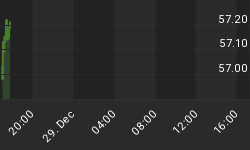Technical signposts at market tops include: 1) negative divergences between price and various momentum oscillators that measure price; 2) deteriorating market internals; 3) excessive bullish sentiment (although this isn't a precise timing marker, bullish sentiment is always seen at a market top); and 4) lack of leadership.
In the current market environment, the "smart money" or professional investor is bearish and the "dumb money" or retail investor is bullish. This can be seen in figure 1 a weekly chart of the NASDAQ. The "smart money" indicator is in the middle panel, and the "Investor Sentiment Composite" or "dumb money" indicator is in the lower panel.
Figure 1. "Smart Money" v. "Dumb Money"
The "smart money" indicator is a composite of three sets of data: 1) the public to specialist short ratio; 2) the specialist short sales ratio; and 3) the ratio of the volume of puts to the volume of calls in the S&P100. Statistically significant extremes in the data are sought and combined into one indicator.
The "Investor Sentiment Composite" or "dumb money" indicator is composed of the following: 1) the Investors Intelligence poll; 2) the American Association of Individual Investors poll; 3) the Market Vane poll; 4) the put-call ratio. This represents four different segments of the investing public. Statistically significant extremes in the data are sought and combined into one indicator.
Since 2001, this combination of bullish "dumb money" and bearish "smart money" has nailed the market top 6 out of 7 times. The only failure was in the bull run of 2003 (green vertical bar with yellow oval). I should also point out that signals labeled 1,2 and 3 in figure1 occurred in the bear market, and these were more precise in their timing. Signals labeled 5,6, and 7, which occurred during the post 2002 bull market, tended to be early.
Prior to 2000, the "smart money" indicator had a poor record of picking market tops, and you can see (green vertical bar with purple oval) how the "smart money" was too bearish too early in the market blow off of 1999 and 2000. It appears (as suggested by the entire data series) that the "smart money" is very good at picking market bottoms in bull markets and very good at picking market tops in bear markets. With regards to picking a top in a bull market or to picking the bottom in a bear market, the "smart money" has a less than stellar record. They have deep pockets but their timing is little suspect.
With market breadth somewhat narrow and negative divergences showing up in a variety oscillators, the current market environment has the technical characteristics associated with market tops. The big question remains: will this time be different?
While negative divergences, waning market internals and overly bullish investor sentiment are all part of the "this time is different" scenario, negative divergences between price and an oscillator used to measure momentum of price are unique because it is a close above the high of the negative divergence bar that says "this time is different". A close above the high of the negative divergence leads to an accelerated price move as traders cover losing short positions. This is what propels prices higher in the "this time is different" scenario.
And this is our signal that the market will continue its run despite the "smart money" being bearish or the "dumb money" being bullish.
















